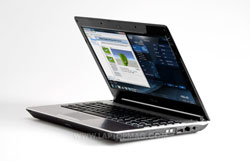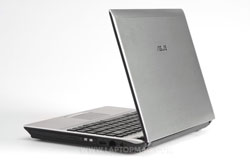Laptop Mag Verdict
Thanks to Nvidia's automatic switchable graphics, this good-looking 13-inch notebook combines gaming cred with long battery life.
Pros
- +
Attractive aluminum design
- +
Good graphics performance
- +
Excellent battery life
- +
Impressive audio quality
- +
Two-year warranty
Cons
- -
Heavy for 13-inch notebook
- -
Glossy screen kicks back reflections
Why you can trust Laptop Mag
Gaming muscle meets long battery life in the the ASUS U30Jc-1A, a 13-inch notebook that can automatically switch between discrete grpahics mode (great for playing games and high-def video) and integrated grpahics mode for when you need more juice. How much juice? This $899 system, powered by a Core i3 CPU,lasts over 7 hours on a charge. The slightly heavy chassis may not be for everyone, but overall the U30Jc is a good value for those who want graphics oomph without sacrificing endurance.
Design
Both the lid and the deck of the U30Jc are covered in a brushed aluminum that resists fingerprints, and, under the right lighting, appears to have a lavender tint. The area around the keyboard is a metallic silver plastic, and the island-style keys are a matte black plastic. The bezel is a glossy black plastic, which picks up fingerprints, but not too much so.
For a 13-inch system, the U30Jc feels rather bulky, weighing in at 4.8 pounds. Measuring 13.1 x 9.5 x 1.2 inches, it's a bit larger and heavier than the UL30A (12.7 x 9.2 x 1 inches, 4 pounds), most likely owing to the inclusion of an optical drive as well as a discrete graphics chip. The Sony VAIO Y, by comparison, has nearly the same dimensions (12.8 x 8.9 x 1.3) inches, but weighs a full pound less.
Heat
Even with its discrete graphics chip running, the U30Jc kept rather cool. After playing a Hulu video at full screen for 15 minutes, the middle of the underside and the touchpad only reached 89 degrees Fahrenheit, and the space between the G and H keys was a balmy 93. The area by the vent reached 100 degrees, which is warm, but we've seen much hotter temperatures from machines this size.
Keyboard and Touchpad
The island style keyboard on the U30Jc offered a decent typing experience. The keys were nicely spaced, but we felt that their pitch was a little too shallow. Neverless, they were responsive when typing, and didn't make too much noise.
The touchpad, covered in the same purplish-brushed aluminum as the wrist rest, is slightly recessed, and bordered by a chrome trim--a nice touch--and was free of friction. The single mouse button below also has a chrome finish. While we prefer discrete buttons, the single bar on the U30Jc worked well.
Display and Audio

Click to enlargeThe 13.3-inch, 1366 x 768-pixel display is well-suited for work and play. Within the optimal viewing angles colors were bright and deep, and high-def video looked great. Horizontal viewing angles are wide enough for three people to share the screen without encountering color distortion. Vertical angles were narrower. Tilting the screen back as far as it would go washed out colors, as did bringing it close to 90 degrees. But there's at least a 10-degree range between those extremes that allow for good viewing.
While watching the 1080p trailer for The Discoverers, we noted good transitions from light to dark, minimal pixelation, and smooth playback even during slow-motion scenes. Unfortunately, the glossy screen meant we often saw our reflection during dark scenes.
The U30Jc's audio quality is superb, but the speakers could benefit from a bit more power. Music barely filled a small room at 50 percent volume. Turning it up to 75 percent allowed us to hear music even over a loud fan, but when we watched Dirty Dancing on Hulu, we had to turn the sound up to 100 percent to hear clearly. The inclusion of SRS Premium Sound gave us hope for decent bass and the U30Jc didn't disappoint. Despite the volume issues, lower tones were both strong and satisfying.
Ports and Webcam
Along the left side of the U30Jc are two USB ports, HDMI, VGA, and a headphone and a mic port. On the right is the tray-loading DVD drive, a third USB port, and Ethernet. The center of the front lip houses a 5-in-1 card slot.
Although the webcam on the U30Jc only has a VGA resolution, it offered excellent visuals. Our skin tones were accurate without being blotchy, and we could clearly make out the individual stripes of our shirt. Finally, there was little to no motion blur when we waved our hand in front of the camera. Asus' LifeFrame 3 utility also lets you fiddle with the image, with options such as changing the resolution up to 640 x 480, adjusting the shutter speed, brigthness, contrast, and adding filters.
Performance
The U30Jc's 2.26-GHz Intel Core i3 350M CPU may not be dynamically overclockable like those of Core i5 or i7 notebooks, but the system notched a very respectable score of 5,334 on PCMark Vantage. That's about 1800 points above the average, 400 points better than the SonyVAIO S (which has a 2.26GHz Core i5-430M CPU, but integrated graphics), and just a shade less than the Toshiba E205 (5,396).
Transcoding a 114MB MPEG4 into AVI using Oxelon Media Encoder took 1 minute and 12 seconds, about 20 seconds longer than the thin-and-light notebook average, but the 320GB, 5,400-rpm hard drive booted to Windows 7 Premium in a speedy 54 seconds. It duplicated a 4.97GB folder of mixed media files in 4:03, or 20.9 MBps, just a hair slower than average.
Graphics
Like the UL50Vf, the U30Jc features Nividia's Optimus switchable graphics technology. Previously, when graphics were rendered by either the integrated or discrete GPU, they had to pass through a multiplexer on the way to the display; switching between the two GPUs would cause the screen to flicker or require a system restart or log out. Optimus works by having intensive video information (such as games or Flash videos) rendered by the discrete GPU, which then swiftly copies the data to the system memory, where the Intel GPU directly drives the display--no multiplexers needed.
With the discrete Nvidia GT 310M GPU activated, the U30Jc notched a score of 3,711 on 3DMark06, a graphics benchmark. That's about 300 points higher than the UL50Vf (which has a lower-powered Nvidia GeForce G210M GPU), and about 500 points higher than the mainstream average. These graphics aren't the cream of the crop: The 11.6-inch Alienware M11x (which has an Nvidia GeForce GT 335M and 1GB of video memory) scored 6388; of course, that system costs $200 more.
Still, the U30Jc is more than adequate for gaming. In World of Warcraft, we upped the effects to ultra and the resolution to native, and still were able to play at a comfortable 34 frames per second, well above the ultraportable average of 18 fps. In Far Cry 2, the game proceeded at a nice 44 fps clip at 1024 x 768, but dropped to just 16 fps with graphics on very high and resolution at 1366 x 768. In Star Trek Online, we destroyed Borg probes at 95 fps with the resolution at 1024 x 768, and 46 fps at the max 1366 x 768. Gameplay was smooth and graphics were richly detailed.
Regardless, the real pleasure lay in the seamless transition between the integrated and discrete GPUs; it was nice not having to press a button or watch the screen flicker when we wanted to perform a more graphics-intensive task such as gaming or watching videos.
Wi-Fi and Battery Life
While we classify the U30Jc as a thin-and-light laptop because of its weight, it has the endurance of an ultraportable. On our LAPTOP Battery Test (Web surfing via Wi-Fi), the notebook lasted 7 hours and 7 minutes, about an hour and a half longer than the ultraportable average, nearly equal to the M11x in integrated mode (7:14), and about 50 minutes longer than the Sony VAIO Y, which has a ULV processor and integrated graphics. Still, the ULV-powered UL30A saw nearly 10 hours of battery life.
The U30Jc's Intel WiFi Link 1000 BGN provided fairly strong throughput at 15 feet from our access point (39.8Mbps)--almost double the thin and light average (21.3)-- but dropped nearly in half at 50 feet (21.4Mbps). At that range, it was only about 4 Mbps faster than the average.
Green Testing
The U30Jc took 1 hours and 29 minutes to recharge to 80 percent, and a total of 2:47 to fully recharge. During that time, it used an average of 53 watts; its LAPTOP Battery Efficiency rating (total watts divided by battery life) of 20.7 is very good, and almost equal to that of the ultraportable average (20.5). The notebook is not rated by EPEAT.
Configurations
ASUS does not offer any other configurations of the U30Jc.
Software and Waranty

Click to enlargeAsus keeps the U30Jc pretty clean: just a 30-day trial of Trend Micro Internet Security, a 60-day trial of Microsoft Office, and Asus' utilities, such as its Splendid video enhancement and WebStorage.
Asus covers the system with a 2-year limited global hardware, 1-year limited Accidental Damage Protection (one occurrence) warranty. The company offers 24/7 toll free technical support and free two-way shipping for repair/service.
Verdict
The U30Jc is a worthy investment for those looking for good graphics performance and long battery life in a fairly portable 13-inch package. Just as important, this handsome aluminum-clad notebook has the brains to know when users require more muscle or more endurance. At $899, the U30JC costs $100 more than the Sony VAIO Y, but you get more power and more time away from an outlet. You just have to be willing to lug around an additional pound.
ASUS U30Jc-1A Specs
| Brand | ASUS |
| CPU | 2.26-GHz Intel Core i3 350M |
| Card Slots | 5-1 card reader |
| Company Website | http://www.asus.com |
| Display Size | 13.3 |
| Hard Drive Size | 320GB |
| Hard Drive Speed | 5,400rpm |
| Hard Drive Type | SATA Hard Drive |
| Native Resolution | 1366x768 |
| Optical Drive | DVD /-RW |
| Optical Drive Speed | 8X |
| Ports (excluding USB) | Microphone, Headphone, HDMI, Ethernet, VGA |
| RAM | 4GB |
| RAM Upgradable to | 8GB |
| Size | 13.1 x 9.5 x 1.2 inches |
| USB Ports | 3 |
| Warranty/Support | ASUS 2-year limited global hardware, 1-year limited Accidental Damage Protection (one occurrence), Free two-way shipping for repair/service, 1-year battery pack, 24/7 Toll Free Technical Support |
| Weight | 4.8 pounds |
| Wi-Fi | 802.11b/g/n |
